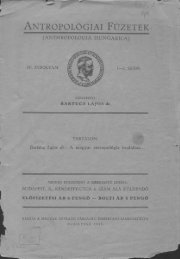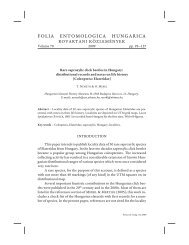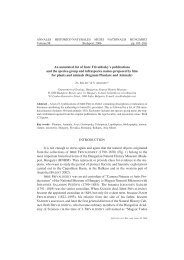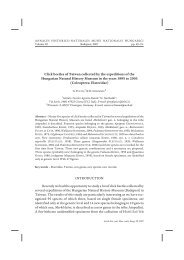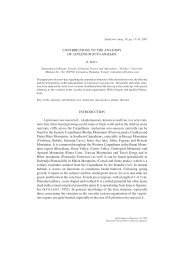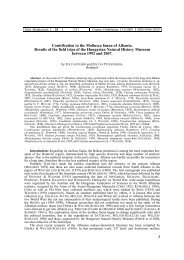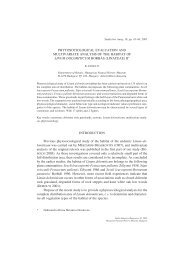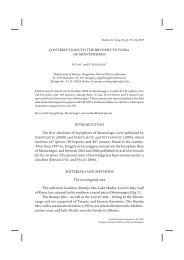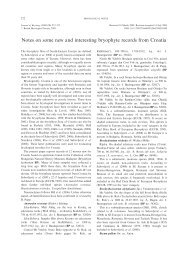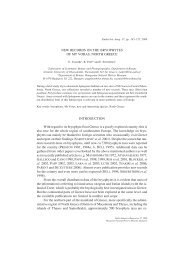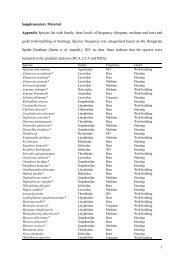THE GENUS SCHISTIDIUM (GRIMMIACEAE, MUSCI) IN HUNGARY ...
THE GENUS SCHISTIDIUM (GRIMMIACEAE, MUSCI) IN HUNGARY ...
THE GENUS SCHISTIDIUM (GRIMMIACEAE, MUSCI) IN HUNGARY ...
Create successful ePaper yourself
Turn your PDF publications into a flip-book with our unique Google optimized e-Paper software.
<strong>THE</strong> <strong>GENUS</strong> <strong>SCHISTIDIUM</strong> <strong>IN</strong> <strong>HUNGARY</strong> 39<br />
Costa and leaf margins smooth. Lamina smooth, in lower part unistratose, in upper part<br />
with bistratose spots. Upper lamina cells rounded, 6–9 μm wide, lower cells wider and<br />
slightly sinuose, basal marginal cells sometimes subhyaline, with slightly thickened<br />
cross-walls. K+ red.<br />
Sporophytes frequent, mostly shallowly immersed. Urn orange to reddish-brown, often<br />
finely striolate, widest below middle, length/width ratio (1.3–)1.4–1.6–1.8 (BLOM<br />
1996), in Hungarian material (0.94–)1.34 ±0.04(–1.93), n = 91. Exothecial cells elongate,<br />
especially in basal part, at least some up to 50 μm (often up to 80 μm) long, arranged in a<br />
regular pattern. Stomata absent. Peristome teeth 220–340 μm, orange, in central and<br />
upper parts mostly strongly perforated to cribrose.<br />
Variability: The exothecial cells in the lower part of the urn sometimes only reach<br />
(50–)55 μm, but in other samples they attain 75–80 μm.<br />
The brown, dense cushions with hair-points only around the sporophytes give this<br />
plant a very characteristic appearance. However, some forms of S. crassipilum can look<br />
quite similar, and in that case the strongly elongate exothecial cells (Fig. 5G, H, compare<br />
with Fig. 13I, J), and the shorter and wider urn of S. brunnescens are diagnostic. Confusion<br />
could also occur with forms of S. helveticum lacking the typical black colour, but again the<br />
pattern of exothecial cells is quite different. For the difference between subsp. brunnescens<br />
and subsp. griseum see the note under the latter.<br />
: S. brunnescens subsp. brunnescens grows nearly exclusively on exposed calcareous<br />
rocks (limestone, dolomite), and is a very typical member of the bryophyte vegetation in<br />
calcareous grasslands. It was found associated with the lichen Fulgensia fulgens (det. V. Otte).<br />
: Bryum argenteum, Didymodon rigidulus, D. vinealis, Grimmia<br />
dissimulata, G. orbicularis, G. pulvinata, Grimmia tergestina, Pseudocrossidium revolutum,<br />
Pseudoleskeella catenulata, Schistidium crassipilum, S. helveticum, Tortella inclinata, Tortula<br />
crinita, Trichostomum sp.<br />
: 150–780 m a.s.l.<br />
: : Comit. Gömör. In rupibus<br />
calc. montis “Baradla-tetõ” prope pag. Aggtelek, 350 m, 03.06.1928, leg. Á. Boros, BP<br />
111757; : Comit. Borsod. In rupibus calcar. montis Bélkõ prope Bélapátfalva,<br />
500–780 m, 03.09.1959, leg. Á. Boros, BP 110944; Lehmschieferfelsen an der<br />
Straßenböschung zwischen Bükkzsérc und Felsõtárkány, ca 400 m, mit S. crassipilum, 27.03.<br />
2008, leg. P. Erzberger and T. Pócs, herb. Erzberger, (B) 12886; :<br />
Glaukonit-Sandsteinfelsen “Noé szõllõje” im Ort Istenmezeje, 230 m, 26.03.2008, leg. P.<br />
Erzberger and T. Pócs, herb. Erzberger, (B) 12861; : Comit. Pest. In<br />
rupibus dolomit. apricis montis Vár-hegy prope Csõvár, 350 m, 06.05.1953, leg. Á. Boros,<br />
BP 111748; : Comit. Pest. In monte Somlyó prope Fóth, 21.05.1901,<br />
leg. Á. Degen, BP 37650; : Comit. Pest. In rupibus dolomiticis merid.<br />
montis Nagykevély prope pag. Pilisborosjenõ, 500 m, 25.03.1947, leg. Á. Boros, BP 111750;<br />
Hung. centr., com. Pest. In rupibus calcareis supra pag. Pomáz, 31.03.1946, leg. L. Vajda,<br />
EGR; : Budakalász, comit. Pest, in monte “Monalovác” ad saxa calcarea,<br />
250 m, III.1911, leg. J. Szurák, revid. M. Péterfi, BP 5645; : Gyermely,<br />
Studia bot. hung. 39, 2008



